#nakauchi tenma
Explore tagged Tumblr posts
Video
youtube
[Video] ミュージカル『薄桜鬼 志譚』 風間千景篇 (musical hakuouki shitan kazama chikage hen)
#薄桜鬼#hakuouki#中河内雅貴#nakauchi tenma#本西彩希帆#motonishi sakiho#和田雅成#wada masanari#山崎晶吾#yamazaki shougo#赤澤燈#akazawa tomoru#樋口裕太#higuchi yuuta#水石亜飛夢#mizushi atomu#井俣太良#imata taira#輝馬#teruma#岸本勇太#kishimoto yuuta#椎名鯛造#shiina taizou#兼崎健太郎#kanesaki kentarou#末野卓磨#sueno takuma#川本裕之#kawamoto hiroyuki
52 notes
·
View notes
Photo
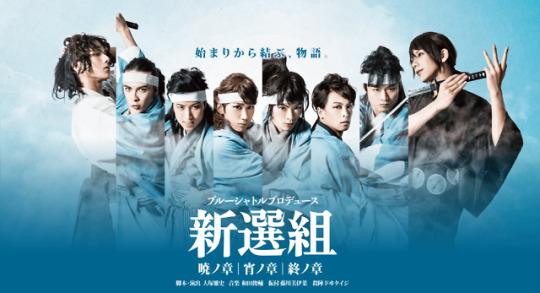
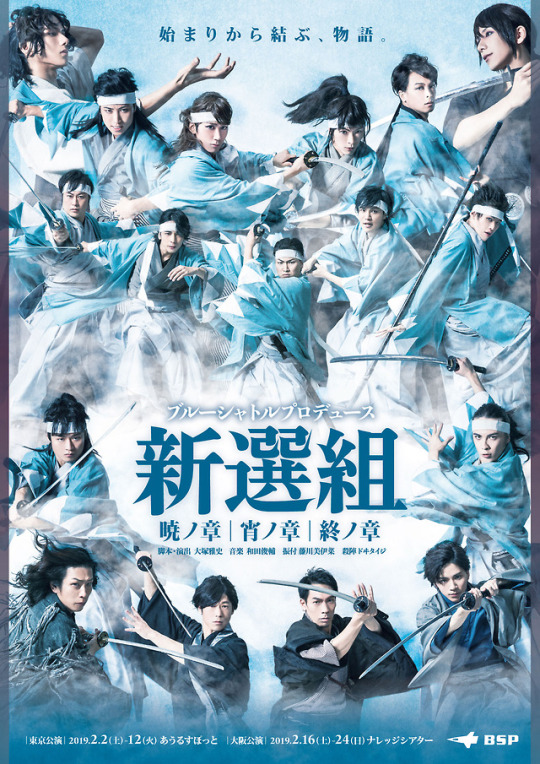
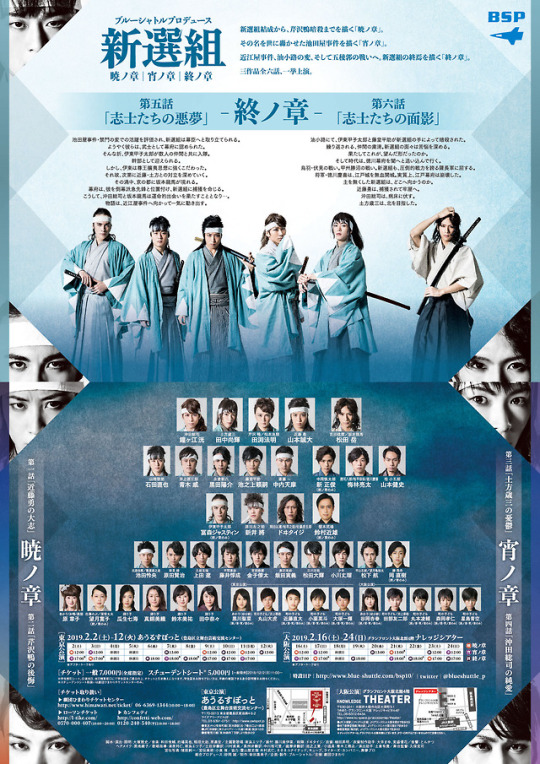
ブルーシャトルプロデュース 「『新選組』完結編」 Shinsengumi Kanketsuhen Shinsengumi: Concluding Chapter
Tokyo 2019.02.02-12 Owl Spot Osaka 2019.02.16-24 Knowledge Theater
HP: http://www.blue-shuttle.com/bsp10/
暁ノ章 / Akatsuki no Shou (Dawn chapter) 「近藤勇の大志」 Kondou Isami no Taishi (The Ambition of Kondou Isami) 「芹沢鴨の後悔」 Serizawa Kamo no Koukai (The Regret of Serizawa Kamo)
宵ノ章 / Yoi no Shou (Evening chapter) 「土方歳三の憂鬱」 Hijikata Toshizou no Yuuutsu (The Melancholy of Hijikata Toshizou) 「沖田総司の純愛」 Okita Souji no Jun'ai (The Pure Love of Okita Souji)
終ノ章 / Tsui no Shou (Final chapter) 「志士たちの悪夢」 Shishi-tachi no Akumu (The Patriots' Nightmare) 「志士たちの面影」 Shishi-tachi no Omokage (The Patriots' Trace)
CAST: Kanegae Kou - Okita Souji Tanaka Naoki - Hijikata Toshizou Tabuchi Noriaki - Serizawa Kamo, Matsumoto Ryoujun Yamamoto Masahiro - Kondou Isami Matsuda Gaku - Yoshida Toshimaro, Sakamoto Ryouma
Ishida Naoya - Yamanami Keisuke Aoki Takeshi - Inoue Genzaburou Kuroda Yousuke - Nagakura Shinpachi Arai Shou - Harada Sanosuke Ikenoue Yoritsugu - Toudou Heisuke Nakauchi Tenma - Saitou Hajime Harada Kenji - Niimi Nishiki Fujii Atsunari - Hirama Juusuke Matsushita Wataru - Hirayama Gorou, Mochizuki Kameyata Matsuda Taiki - Tachikawa Chikara Iida Torayoshi - Okuzawa Eisuke Umebayashi Ryouta - Matsudaira Katamori, Kiyokawa Hachirou, Tokugawa Yoshinobu Yamamoto Kenji - Katsura Kogorou Ueda Ryou - Kusaka Genzui Ikeda Reo - Kitazoe Kitsuma, Shinohara Tainoshin Kaneko Ryouta - Miyabe Teizou Ogawa Takeru - a boy Hara Akiko - Akari, Oume, Black cat Doi Taiji - Okada Izou, Katsura Hayanosuke, Satou Hikogorou
"Tsui no Shou" only: Tomimori Justin - Itou Kashitarou Suzumura Chikao - Enomoto Takeaki Shin Masatoshi - Nakaoka Shintarou Oka Naoki - Katsu Kaishuu Mochizuki Hiroko - Satou Nobu, Miyuki tayuu
STAFF: Director: Ootsuka Masashi Music: Wada Shunsuke Choreography: Fujikawa Miina
4 notes
·
View notes
Photo

[Pics] ミュージカル『薄桜鬼 志譚』 風間千景篇 (musical hakuouki shitan kazama chikage hen)
visuals update under the cut^^
Cast:

Nakagauchi Masataka as Kazama Chikage (風間千景)

Motonishi Sakiho as Yukimura Chizuru (雪村千鶴)

Wada Masanari as Hijikata Toshizou (土方歳三)

Yamazaki Shougo as Okita Souji (沖田総司)

Akazawa Tomoru as Saitou Hajime (斎藤一)

Higuchi Yuuta as Toudou Heisuke (藤堂平助)

Mizuishi Atomu as Harada Sanosuke (原田左之助)

Imata Taira as Kondou Isami (近藤勇)

Teruma as Sannan Keisuke (山南敬助)

Kishimoto Yuuta as Nagakura Shinpachi (永倉新八)

Shiina Taizou as Yamazaki Susumu (山崎烝)

Kanesaki Kentarou as Amagiri Kyuuju (天霧九寿)

Sueno Takuma as Shiranui Ryou (不知火匡)

Kawamoto Hiroyuki as Yukimura Koudou (雪村綱道)
homepage twitter natalie enterstage
#薄桜鬼#hakuouki#中河内雅貴#nakauchi tenma#本西彩希帆#motonishi sakiho#和田雅成#wada masanari#山崎晶吾#yamazaki shougo#赤澤燈#akazawa tomoru#樋口裕太#higuchi yuuta#水石亜飛夢#mizushi atomu#井俣太良#imata taira#輝馬#teruma#岸本勇太#kishimoto yuuta#椎名鯛造#shiina taizou#兼崎健太郎#kanesaki kentarou#末野卓磨#sueno takuma#川本裕之#kawamoto hiroyuki
22 notes
·
View notes
Photo

[Announcement] ミュージカル『薄桜鬼 志譚』 風間千景篇 (musical hakuouki shitan kazama chikage hen)
you will be able to watch it @ dmm (April 21st, 2019 ~ 16:30) [remember that you need to use a VPN to watch/download the show^^]
price: ¥3.600
[delay stream will be available from April 27th, 2019 (18:00) to May 4th, 2019 (23:59)]
if you need help with dmm, take a look at riku’s guide here on tumblr ♡
thx @mandilo for already pointing it out yesterday♡
#薄桜鬼#hakuouki#中河内雅貴#nakauchi tenma#本西彩希帆#motonishi sakiho#和田雅成#wada masanari#山崎晶吾#yamazaki shougo#赤澤燈#akazawa tomoru#樋口裕太#higuchi yuuta#水石亜飛夢#mizushi atomu#井俣太良#imata taira#輝馬#teruma#岸本勇太#kishimoto yuuta#椎名鯛造#shiina taizou#兼崎健太郎#kanesaki kentarou#末野卓磨#sueno takuma#川本裕之#kawamoto hiroyuki
7 notes
·
View notes
Photo

[Pics] BSP『新選組』完結編 (bsp shinsengumi kanketsu hen)
visuals update under the cut^^
Cast:

Kanegae Kou as Okita Souji (沖田総司)

Tanaka Naoki as Hijikata Toshizou (土方歳三)
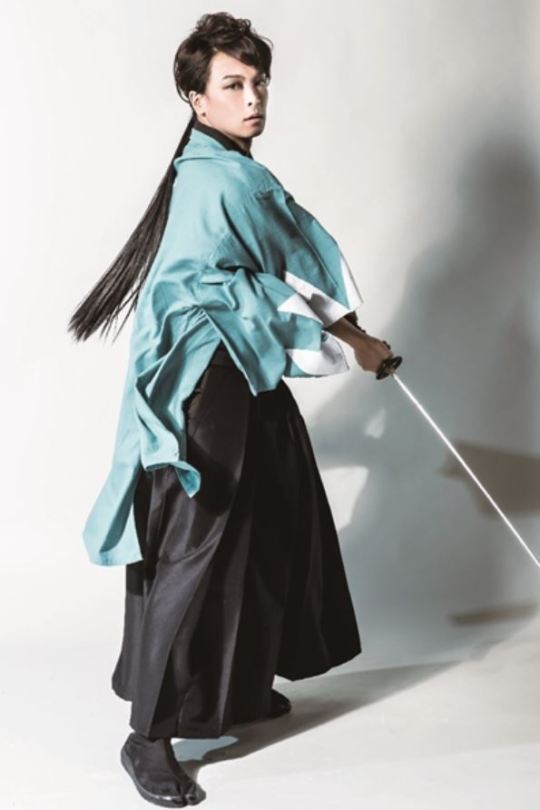
Tabuchi Noriaki as Serizawa Kamo (芹沢鴨)
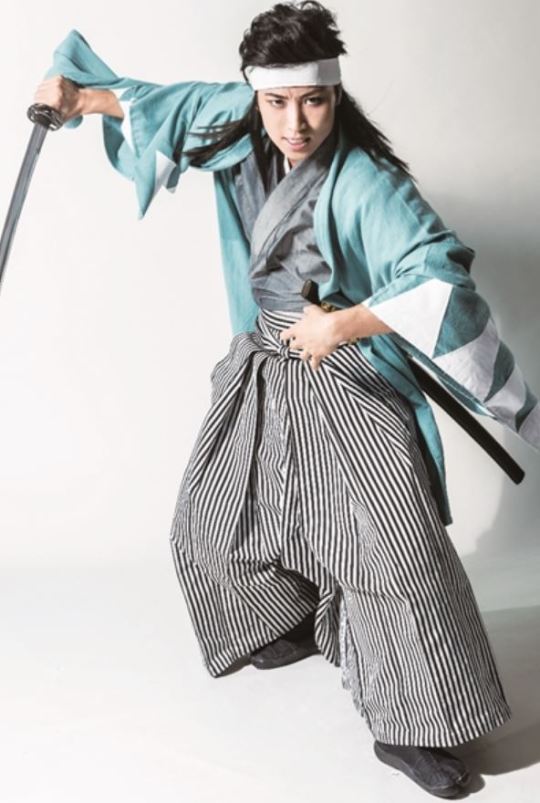
Yamamoto Masahiro as Kondou Isami (近藤勇)

Ishida Naoya as Yamanami Keisuke (山南敬助)
Aoki Takeshi as Inoue Genzaburou (井上源三郎) Kuroda Yousuke as Nagakura Shimpachi (永倉新八) Ikenoue Yoritsugu as Toudou Heisuke (藤堂平助) Nakauchi Tanma as Saitou Hajime (斎藤一) Harada Kenji as Niimi Nishiki (新見錦) Fujii Toshinari as Hirama Juusuke (平間重助) Matsuda Hiroki as Tachikawa Chikara (立川主税) Iida Torayoshi as Okuzawa Eisuke (奥沢栄助) Shin Masatoshi as Nakaoka Shintarou (中岡慎太郎) (終ノ章のみ) Umebayashi Ryouta as Matsudaira Katamori / Kiyokawa Hachirou (松平容保 / 清河八郎) Yamamoto Kenji as Kido Takayoshi (桂小五郎) Suzumura Chikao as Enomoto Takeaki (榎本武揚)(終ノ章のみ) Ueda Ryou as Kusaka Genzui (久坂玄瑞) Nagano Tasuku as Mochizuki Kameyata (望月亀弥太) Ikeda Reo as Kitazoe Litsuma (北添佶麿) Kaneko Ryouta as Miyabe Teizou (宮部鼎蔵) Ogawa Takeru as Boy (少年) Hara Akiko as Akari / Oume (あかり / お梅)

Tomimori Justin as Ito Kashitarou (伊東甲子太郎)(終ノ章のみ) Arai Shou as Harada Sanosuke (原田左之助) Doi Taiji as Okada Izou (岡田以蔵)
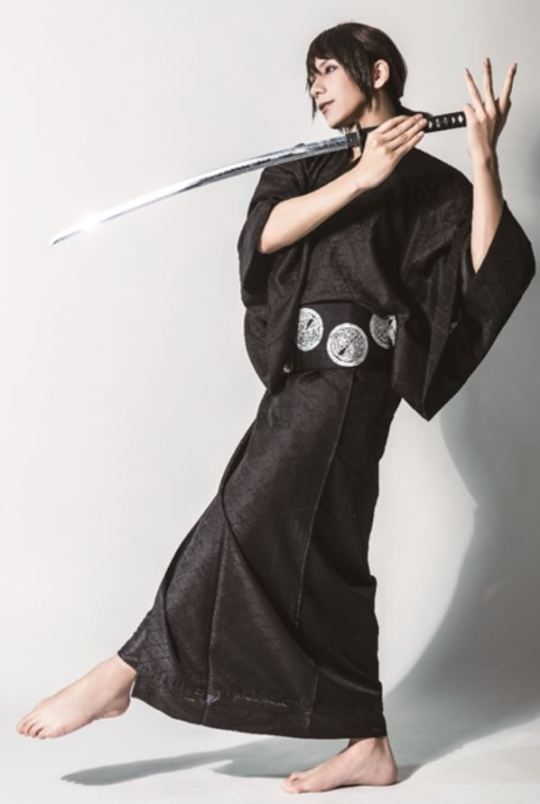

Matsuda Gaku as Yoshida Toshimaro / Sakamoto Ryouma (吉田稔麿 / 坂本龍馬)
homepage twitter sumabo
#新選組#shinsengumi#鐘ヶ江洸#kanegae kou#田中尚輝#tanaka naoki#田渕法明#tabuchi noriaki#山本誠大#yamamoto masahiro#石田直也#ishida naoya#青木威#aoki takeshi#黒田陽介#kuroda yousuke#池之上頼嗣#ikenoue yoritsugu#中内天摩#nakauchi tenma#原田賢治#harada kenji#藤井惇成#fujii toshinari#松田大輝#matsuda hiroki#飯田寅義#iida torayoshi#新正俊#shin masatoshi
11 notes
·
View notes
Photo


[Update] BSP『新選組』完結編 (bsp shinsengumi kanketsu hen)
cast update under the cut^^
Cast:
Kanegae Kou as Okita Souji (沖田総司) Tanaka Naoki as Hijikata Toshizou (土方歳三) Tabuchi Noriaki as Serizawa Kamo (芹沢鴨) Yamamoto Masahiro as Kondou Isami (近藤勇) Ishida Naoya as Yamanami Keisuke (山南敬助) Aoki Takeshi as Inoue Genzaburou (井上源三郎) Kuroda Yousuke as Nagakura Shimpachi (永倉新八) Ikenoue Yoritsugu as Toudou Heisuke (藤堂平助) Nakauchi Tanma as Saitou Hajime (斎藤一) Harada Kenji as Niimi Nishiki (新見錦) Fujii Toshinari as Hirama Juusuke (平間重助) Matsuda Hiroki as Tachikawa Chikara (立川主税) Iida Torayoshi as Okuzawa Eisuke (奥沢栄助) Shin Masatoshi as Nakaoka Shintarou (中岡慎太郎) (終ノ章のみ) Umebayashi Ryouta as Matsudaira Katamori / Kiyokawa Hachirou (松平容保 / 清河八郎) Yamamoto Kenji as Kido Takayoshi (桂小五郎) Suzumura Chikao as Enomoto Takeaki (榎本武揚)(終ノ章のみ) Ueda Ryou as Kusaka Genzui (久坂玄瑞) Nagano Tasuku as Mochizuki Kameyata (望月亀弥太) Ikeda Reo as Kitazoe Litsuma (北添佶麿) Kaneko Ryouta as Miyabe Teizou (宮部鼎蔵) Ogawa Takeru as Boy (少年) Hara Akiko as Akari / Oume (あかり / お梅) Tomimori Justin as Ito Kashitarou (伊東甲子太郎)(終ノ章のみ) Arai Shou as Harada Sanosuke (原田左之助) Doi Taiji as Okada Izou (岡田以蔵) Matsuda Gaku as Yoshida Toshimaro / Sakamoto Ryouma (吉田稔麿 / 坂本龍馬)
homepage twitter natalie
#新選組#shinsengumi#鐘ヶ江洸#kanegae kou#田中尚輝#tanaka naoki#田渕法明#tabuchi noriaki#山本誠大#yamamoto masahiro#石田直也#ishida naoya#青木威#aoki takeshi#黒田陽介#kuroda yousuke#池之上頼嗣#ikenoue yoritsugu#中内天摩#nakauchi tenma#原田賢治#harada kenji#藤井惇成#fujii toshinari#松田大輝#matsuda hiroki#飯田寅義#iida torayoshi#新正俊#shin masatoshi
9 notes
·
View notes
Photo

[Update] BSP「日本史Rock show Vol.2『応仁の乱』(bsp nihonshi rock show vol.2 ounin no ran)
visuals update under the cut^^
Cast:

Matsuda Gaku as Ashikaga Yoshimasa (足利義政)

Tabuchi Noriaki as Hino Tomiko (日野富子)

Tanaka Naoki as Hosokawa Katsumoto (細川勝元)

Kanegae Kou as Yamana Souzen (山名宗全)

Ishida Naoya as Ashikaga Yoshimi (足利義視)

Ikenoue Yoritsugu as Onami (音阿弥)

Yamamoto Kenji as Ikkyuu Soujun (一休宗純)

Harada Kenji as Oouchi Masahiro (大内政弘)

Ueda Ryou as Ise Sadachika (伊勢貞親)

Nakauchi Tenma as Hatakeyama Yoshinari (畠山義就)

Ogawa Takeru as Hatakeyama Masanaga (畠山政長)

Morita Taiko as Asakura Takakage (朝倉孝景)
homepage twitter natalie
#日本史Rock show#nihonshi rock show#松田岳#matsuda gaku#田渕法明#tabuchi noriaki#田中尚輝#tanaka naoki#鐘ヶ江洸#kanegae kou#石田直也#ishida naoya#池之上頼嗣#ikenoue yoritsugu#山本健史#yamamoto kenji#原田賢治#harada kenji#上田遼#ueda ryou#中内天摩#nakauchi tenma#小川丈瑠#ogawa takeru#森田大鼓#morita taiko
6 notes
·
View notes
Photo

[Announcement] BSP「日本史Rock show Vol.2『応仁の乱』(bsp nihonshi rock show vol.2 ounin no ran)
the show will be running from June 10th, 2021 to June 14th, 2021 (Osaka) @ ABCホール (ABC Hall) & June 18th, 2021 to June 27th, 2021 (Tokyo) @ シアター代官山 (Theater Daikanyama)
Cast:
Matsuda Gaku Tabuchi Noriaki Tanaka Naoki Kanegae Kou Ishida Naoya Ikenoue Yoritsugu Yamamoto Kenji Harada Kenji Ueda Ryou Nakauchi Tenma Ogawa Takeru Morita Taiko
homepage twitter natalie
#日本史Rock show#nihonshi rock show#松田岳#matsuda gaku#田渕法明#tabuchi noriaki#田中尚輝#tanaka naoki#鐘ヶ江洸#kanegae kou#石田直也#ishida naoya#池之上頼嗣#ikenoue yoritsugu#山本健史#yamamoto kenji#原田賢治#harada kenji#上田遼#ueda ryou#中内天摩#nakauchi tenma#小川丈瑠#ogawa takeru#森田大鼓
4 notes
·
View notes
Text
Cast and characters for some BSP plays
in chronological order
BSP「壬生狼」
“Miburo” / “The Wolves of Mibu” (2014.1)
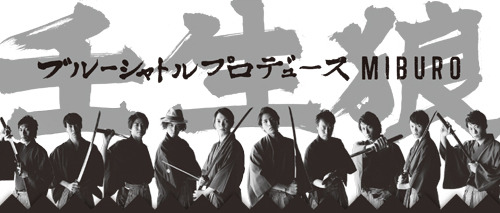
Info: site, DVD, PV
CAST:
Matsuda Gaku - Hijikata Toshizou Tabuchi Noriaki - Okita Souji Aoki Takeshi - Kondou Isami Tokura Yuuki - Serizawa Kamo Kanegae Kou - Yamanami Keisuke Yamamoto Masahiro - Saitou Hajime Tanaka Naoki - Toudou Heisuke Kitaguchi Shouhei - Harada Sanosuke Hirayama Shou - Nagakura Shinpachi Yamasaki Touma - Tachikawa Chikara Umebayashi Ryouta - Katsura Kogorou Yamamoto Kenji - Sakamoto Ryouma, etc.
Director: Ootsuka Masashi Music: Wada Shunsuke, Matoda Hideya Choreography: Kakitani Yui
BSP「幸村」-真田戦記-
“YUKIMURA - Sanada Senki” / “YUKIMURA - Sanada’s War History” (2015.3,5)

Info: site, DVD, PV
CAST:
Matsuda Gaku - Sanada Nobushige (a.k.a. Yukimura) Tabuchi Noriaki - Tokugawa Ieyasu, Yodo-dono Tanaka Naoki - Sarutobi Sasuke Umebayashi Ryouta - Mouri Katsunaga Aoki Takeshi - Gotou Matabei Ishida Naoya - Toyotomi Hideyori Yamamoto Masahiro - Chousokabe Morichika Kanegae Kou - Akashi Teruzumi Yamamoto Kenji - Oono Harunaga Kitaguchi Shouhei - Tokugawa Hidetada Kuroda Yousuke - Kirigakure Saizou Nakauchi Tenma - Sanada Daisuke Ogawa Katsuya - Sanada Nobuyuki, etc.
Director: Ootsuka Masashi Music: Wada Shunsuke Choreography: Kakitani Yui
Theme Song: "Glorious Death" Lyrics: Ootsuka Masashi; music: Wada Shunsuke; vocal: Niira Etsuko
BSP「雪の女王」(BSP版)
“Yuki no Joou” / “The Snow Queen” (BSP edition) (2015.9-11)

Info: site, DVD, PV
CAST:
Hanafusa Chika - Karen Terashita Remi - Anna Matsuda Gaku - Chris Aoki Takeshi - Carl Umebayashi Ryouta - Gert Ishida Naoya - Abel Hara Kouki - Elmer Tabuchi Noriaki - Chris' Shadow Yamamoto Masahiro - Carl's Shadow Tanaka Naoki - Gert's Shadow Harada Kenji - Abel's Shadow Shin Masatoshi - Elmer's Shadow Yamamoto Kenji - the nonexistent
Director: Ootsuka Masashi Music: Matoda Hideya Choreography: Kakitani Yui
BSP「 真田幸村 」
“Sanada Yukimura” (2016.3-4)
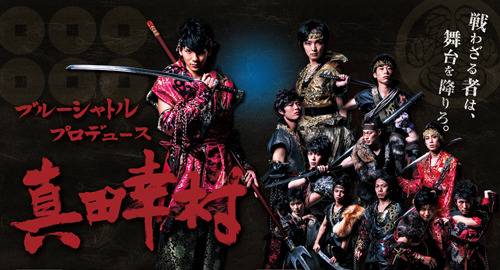
Info: site, DVD, PV
CAST:
Matsuda Gaku - Sanada Nobushige, Takeda Shingen Tabuchi Noriaki - Tokugawa Ieyasu, Yodo-dono Umebayashi Ryouta - Uesugi Kagekatsu, Sanada Nobuyuki Tanaka Naoki - Sarutobi Sasuke, Sanada Daisuke Ishida Naoya - Toyotomi Hideyoshi, Sen-hime Aoki Takeshi - Gotou Matabei, Miyoshi Seikai Nyuudou Kanegae Kou - Oda Nobunaga, Mochizuki Chiyome Yamamoto Masahiro - Toyotomi Hideyori, Kirigakure Saizou Kuroda Yousuke - Nezu Jinpachi, Chousokabe Morichika Ogawa Katsuya - Mochizuki Rokurou, Mouri Katsunaga Yamamoto Kenji - Sanada Masayuki, Tokugawa Hidetada Tokura Yuuki - Hattori Hanzou, Oono Harunaga, etc.
Director: Ootsuka Masashi Music: Wada Shunsuke Choreography: Kakitani Yui
BSP「龍の羅針盤」 “Ryuu no Rashinban” / “Dragon Compass”
第一部 幕末死闘篇 (2016.11-12) Part 1 - Bakumatsu shitou hen / Bakumatsu death battle 第二部 維新回天篇 (2017.2) Part 2 - Ishin kaiten hen / The changing world of the [Meiji] Restoration

Info: site, DVD1, DVD2, PV, OP dance part 1, part 2
CAST:
Matsuda Gaku - Sakamoto Ryouma Tabuchi Noriaki - Thomas Blake Glover Umebayashi Ryouta - Katsu Kaishuu Ishida Naoya - Iwasaki Yatarou Aoki Takeshi - Takechi Hanpeita, Ookubo Toshimichi Yamamoto Masahiro - Takasugi Shinsaku Kuroda Yousuke - Saitou Hajime Ikenoue Yoritsugu - Gotou Shoujirou Nakauchi Tenma - Itou Hirobumi Shin Masatoshi - Kondou Choujirou Fujita Kyouhei - Mochizuki Kameyata Sawada Makoto - Murata Shinpachi Yamamoto Kenji - Saigou Takamori Part 2 only: Tanaka Naoki - Nakaoka Shintarou Kanegae Kou - Katsura Kogorou Tokura Yuuki - Tokugawa Yoshinobu
Director: Ootsuka Masashi Music: Wada Shunsuke, Matoda Hideya, Toyoda Kensuke Choreography: Kakitani Yui
Theme Songs: Part 1: "Tasogare no Umi no Ryuu" 「黄昏の海の龍」 Lyrics: Ootsuka Masashi; music: Wada Shunsuke; vocal: Niira Etsuko Part 2: "Suiheisen ni Kieta Rashinban" 「水平線に消えた羅針盤」 Lyrics: Ootsuka Masashi; music: Toyoda Kensuke; vocal: Niira Etsuko
#Matsuda Gaku#cast list#BSP Yuki no Joou#BSP Sanada Yukimura#BSP Yukimura Sanada Senki#BSP Miburo#BSP Ryuu no Rashinban
16 notes
·
View notes